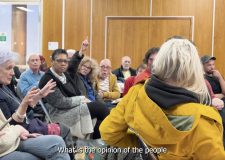Brighton MP goes on trial over anti-fracking protest
Brighton Pavilion MP Caroline Lucas appeared in court today (Monday 24 March) after her arrest at an anti-fracking protest in Balcombe last summer.
She and four other protesters were charged with obstructing a highway and breaching public order by refusing to move after being ordered to do so by a police officer.
At Brighton Magistrates’ Court a recording of her arrest was shown – after a delay while court staff searched for a missing remote control.
It showed a melee during which the Green MP was heard to shout, “That’s my son! That’s my son!” as Theo, the eldest of her two sons, was arrested and physically removed.
The DVD recording then showed Lucas with her head on the shoulder of the woman next to her.
Shortly after she was told that she was under arrest and forcibly removed from the group of protesters outside the site where fracking company Cuadrilla wanted to carry out test drilling.
Jonathan Edwards, prosecuting, said: “Fracking is a controversial process.”
Fracking – hydraulic fracturing – is a process used to extract shale gas by blasting chemicals and high volumes of water into rocks deep underground.
Mr Edwards said that about 300 protesters occupied the B2036 London Road in the West Sussex village – and the wide grass verges either side of the road – on Monday 19 August.
They were trying to block the entrance to the Cuadrilla site to prevent the company from drilling there.
He said people were sitting in the road and taking direct action including “lock-ons” – a technique which involves protesters attaching themselves to other people or objects such as gates.
On Friday 16 August Deputy Chief Constable Giles York was in charge of Sussex Police while Chief Constable Martin Richards was on holiday.
Mr Richards retired last month.
After a briefing by Superintendent Jane Derrick, Mr York agreed that it was necessary to issue an order under section 14 of the Public Order Act.
This designated an area where the police order protesters to go to as a way of maintaining public order.
Mr Edwards said that an officer read aloud the terms of the section 14 notice – akin to reading the Riot Act – and police officers entered the crowd to explain what was required.
A printed notice was also handed out to some of the protesters including the Green MP.
He said that the protesters were told to move to the designated area off the road and those that refused were arrested.
All were represented, all were interviewed and they all answered, “No comment,” he said.
Mr Edwards later corrected himself by saying that Caroline Lucas did answer questions and was not represented.
She said that she and others had sat down at 10.30am at which time there was no indication of a designated area.
She wanted to send a clear message to the government that fracking was not wanted or needed.
She did not believe that she was blocking anybody from gaining access to that site as there was no drilling taking place.
She did not move when asked, she said, because she wanted to show solidarity with her fellow demonstrators.
Mr Edwards said that the defendants would tell the court that they were acting reasonably and proportionately.
The failure of the five defendants to comply with the order was due to circumstances beyond their individual control.
The defendants were variously unaware of or unclear about the conditions of the notice.
Mr Edwards said that it was also asserted that the conditions themselves were unlawful because the senior officer present had no reasonable belief of their necessity.
The order was not reviewed, it was unreasonable, disproportionate and excessive and insufficiently communicated.
It was vague and contradictory, arbitrarily enforced and, the defendants believe, if the police had not closed the road, then traffic could have passed.
They also say that there was no need for emergency access to be maintained at all times by Cuadrilla as no drilling was taking place that day.
Mr York was the first witness for the prosecution and spent about three hours in the witness box.
He said: “I met with Chief Superintendent Tony Blaker, the gold commander, and Superintendent Jane Derrick, the silver commander.
“The gold commander sets the strategy. The silver commander has responsibility for developing the tactical plan to meet that strategy and the bronze commander has responsibility for putting that strategy into effect on the ground.”
He said that they met at about midday on Friday 16 August, adding: “The purpose of the meeting was to seek my authority for silver’s tactical plan to use section 14.
“The tactical plan was there to deal with the extra gathering of people colloquially referred to as the climate camp.”
He said that he had visited during the week before and was aware of two situations – the main continuing demonstrations and the anticipated climate camp.
The climate camp had been expected to take place in Nottingham but intelligence suggested a late switch of venue to Balcombe, he said.
“There was a draft section 14 authority which they brought with them for me to consider.”
Asked about its purpose, Mr York said: “It was to give a tactical option in planning for the weekend for a change in the nature of the assembly and protest that we had experienced to date.
“One was the number of people who would be attending to protest over a protracted period.
“But what had changed was the number of people proposing to live near the site.”
He said that he wasn’t completely satisfied with the wording of the draft notice as he had concerns around facilitating lawful and meaningful protest.
He felt that the potesters should be close enough to the test drilling site for the demonstration to have significance.
He added: “I was trying to balance that with the needs of the people who had chosen to work at the site.
“I was also conscious of safety and the need to maintain emergency access.
“I believed there could be serious disorder and significant disruption to the community.”
He authorised the notice having been told that between 1,500 and 2,000 could turn up at Balcombe.
Mr Edwards had already said in his opening statement that about 300 people were believed to be present when Caroline Lucas and her co-defendants were arrested.
The defendants are Caroline Lucas, 53, of Springfield Road, Brighton, Josef Dobraszczyk, 22, of Kingsway Avenue, Bristol, Ruth Jarman, 50, of Kiln Gardens, Hartley Wintney, Hook, Hampshire, Sheila Menon, 42, of Pellerin Road, north London, and Ruth Potts, 39, of Pomeroy House, Bridgetown, Totnes, Devon, are charged with the same offences.
All five deny the charges. The trial, being heard by District Judge Tim Pattinson, continues.























